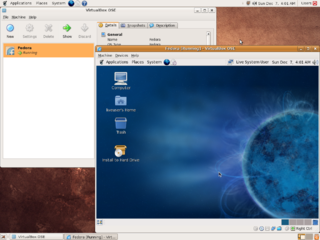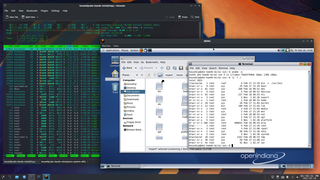Related Research Articles

In computing, a virtual machine (VM) is the virtualization or emulation of a computer system. Virtual machines are based on computer architectures and provide the functionality of a physical computer. Their implementations may involve specialized hardware, software, or a combination of the two. Virtual machines differ and are organized by their function, shown here:

In computing, virtual memory, or virtual storage, is a memory management technique that provides an "idealized abstraction of the storage resources that are actually available on a given machine" which "creates the illusion to users of a very large (main) memory".

In computer architecture, 64-bit integers, memory addresses, or other data units are those that are 64 bits wide. Also, 64-bit central processing units (CPU) and arithmetic logic units (ALU) are those that are based on processor registers, address buses, or data buses of that size. A computer that uses such a processor is a 64-bit computer.

x86-64 is a 64-bit version of the x86 instruction set, first announced in 1999. It introduced two new modes of operation, 64-bit mode and compatibility mode, along with a new 4-level paging mode.
In computer operating systems, memory paging is a memory management scheme by which a computer stores and retrieves data from secondary storage for use in main memory. In this scheme, the operating system retrieves data from secondary storage in same-size blocks called pages. Paging is an important part of virtual memory implementations in modern operating systems, using secondary storage to let programs exceed the size of available physical memory.
In computing, Physical Address Extension (PAE), sometimes referred to as Page Address Extension, is a memory management feature for the x86 architecture. PAE was first introduced by Intel in the Pentium Pro, and later by AMD in the Athlon processor. It defines a page table hierarchy of three levels (instead of two), with table entries of 64 bits each instead of 32, allowing these CPUs to directly access a physical address space larger than 4 gigabytes (232 bytes).
In computer science, thrashing occurs in a system with virtual memory when a computer's real storage resources are overcommitted, leading to a constant state of paging and page faults, slowing most application-level processing. This causes the performance of the computer to degrade or even collapse. The situation can continue indefinitely until the user closes some running applications or the active processes free up additional virtual memory resources.
A hypervisor, also known as a virtual machine monitor (VMM) or virtualizer, is a type of computer software, firmware or hardware that creates and runs virtual machines. A computer on which a hypervisor runs one or more virtual machines is called a host machine, and each virtual machine is called a guest machine. The hypervisor presents the guest operating systems with a virtual operating platform and manages the execution of the guest operating systems. Unlike an emulator, the guest executes most instructions on the native hardware. Multiple instances of a variety of operating systems may share the virtualized hardware resources: for example, Linux, Windows, and macOS instances can all run on a single physical x86 machine. This contrasts with operating-system–level virtualization, where all instances must share a single kernel, though the guest operating systems can differ in user space, such as different Linux distributions with the same kernel.
Platform virtualization software, specifically emulators and hypervisors, are software packages that emulate the whole physical computer machine, often providing multiple virtual machines on one physical platform. The table below compares basic information about platform virtualization hypervisors.
In computing, Intel's Advanced Programmable Interrupt Controller (APIC) is a family of programmable interrupt controllers. As its name suggests, the APIC is more advanced than Intel's 8259 Programmable Interrupt Controller (PIC), particularly enabling the construction of multiprocessor systems. It is one of several architectural designs intended to solve interrupt routing efficiency issues in multiprocessor computer systems.

Out of memory (OOM) is an often undesired state of computer operation where no additional memory can be allocated for use by programs or the operating system. Such a system will be unable to load any additional programs, and since many programs may load additional data into memory during execution, these will cease to function correctly. This usually occurs because all available memory, including disk swap space, has been allocated.
In computing. Physical-to-Virtual involves the process of decoupling and migrating a physical server's operating system (OS), applications, and data from that physical server to a virtual-machine guest hosted on a virtualized platform.
In computing, virtualization is the use of a computer to simulate another computer. The following is a chronological list of virtualization technologies.

VMware ESXi is an enterprise-class, type-1 hypervisor developed by VMware, a subsidiary of Broadcom, for deploying and serving virtual computers. As a type-1 hypervisor, ESXi is not a software application that is installed on an operating system (OS); instead, it includes and integrates vital OS components, such as a kernel.
A virtual security switch is a software Ethernet switch with embedded security controls within it that runs within virtual environments such as VMware vSphere, Citrix XenDesktop, Microsoft Hyper-V and Virtual Iron. The primary purpose of a virtual security switch is to provide security measures such as isolation, control and content inspection between virtual machines.

In computing, virtualization (v12n) is a series of technologies that allows dividing of physical computing resources into a series of virtual machines, operating systems, processes or containers.

The Rackspace Cloud is a set of cloud computing products and services billed on a utility computing basis from the US-based company Rackspace. Offerings include Cloud Storage, virtual private server, load balancers, databases, backup, and monitoring.
Second Level Address Translation (SLAT), also known as nested paging, is a hardware-assisted virtualization technology which makes it possible to avoid the overhead associated with software-managed shadow page tables.
In operating systems, memory management is the function responsible for managing the computer's primary memory.
In computing, a system virtual machine is a virtual machine (VM) that provides a complete system platform and supports the execution of a complete operating system (OS). These usually emulate an existing architecture, and are built with the purpose of either providing a platform to run programs where the real hardware is not available for use, or of having multiple instances of virtual machines leading to more efficient use of computing resources, both in terms of energy consumption and cost effectiveness, or both. A VM was originally defined by Popek and Goldberg as "an efficient, isolated duplicate of a real machine".
References
- ↑ Portnoy, Matthew (2012). Virtualization Essentials . John Wiley & Sons. pp. 60. ISBN 978-1118240175.
- ↑ Siebert, Eric (2009). VMware VI3 Implementation and Administration . Prentice Hall Professional. pp. 166. ISBN 978-0137008599.
- ↑ "VMware vs. Microsoft: Why Memory Overcommitment is Useful in Production and Why Microsoft Denies it". Archived from the original on 5 March 2016. Retrieved 22 April 2015.
{{cite web}}: CS1 maint: bot: original URL status unknown (link) - ↑ Santosa, Mulyadi. "When Linux Runs Out of Memory". O'Reilly Media. Retrieved 22 April 2015.